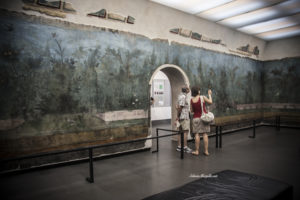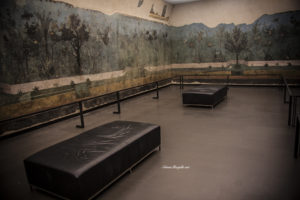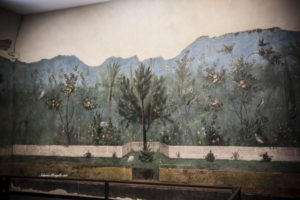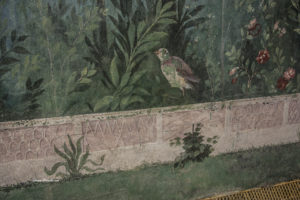The nymphaeum of Livia
(Italian version below*)
Livia Drusilia, the third wife of Emperor Ottaviano Augusto, had at her disposal, at the villa of Prima Porta (Villa d’Otium – in the countryside), an underground room whose intended use is still unknown.
Generally, we want to identify it as a “hypogeum nymphaeum”, typical of the Roman villas and used to defend against the heat in the summer months.
The environment was discovered for the first time during the excavations carried out in 1863 (the frescoes detached following a precious work of the ICR are visible at the National Museum of Palazzo Massimo).
The pictorial decoration with a bucolic theme is one of the oldest examples in Rome of the so-called late Second Pompeian style (38-20 BC).
The subject refers to the paradises of the Hellenistic age; it is an idealized garden, rich in fauna and floral species placed on a blue background, but perfectly identifiable. It’s a book of botany from the imperial age! Awesome!
Roses, daisies, poppies, holm oaks, myrtle oleanders are recognized and among the birds, the blackbird, the sparrow, and the dove are recognized.
The elements, represented in different dimensional scales, also guarantee an illusionist perspective, the attentive gaze of the observer manages to see depth and realism at the same time.
Among the plant species depicted, the most frequent is that of laurel.
The laurel can be traced back to the legend handed down to us by various authors, according to which one day, while Livia went to her villa, an eagle would have dropped a hen with a laurel branch in its beak on her belly (hence the name of the Villa ad Gallinas Albas).
Livia raised the offspring of the bird and planted a twig of laurel giving life to a very luxurious forest. From that wood, the emperors collected the twigs to be held in hand during the battles and for their triumphs.
The emperor’s evergreen garden intrinsically enclosed the concept of the auspicious eternity of plants and consequently of the Augustan lineage.
… Perhaps not everyone knows that … A statue of the Emperor was also found in the Villa of Prima Porta Augustus now preserved in the Vatican Museums!
InfoSite: Palazzo Massimo National Museum
All rights reserved*
Livia Drusilia, terza moglie dell’Imperatore Ottaviano Augusto, aveva a sua disposizione, presso la Villa familiare di Prima Porta (Villa d’Otium) una camera sotterranea di cui ancora non si conosce perfettamente la destinazione d’uso.
Generalmente la si vuole identificare come un “ninfeo ipogeo”, tipico delle Ville romane ed utilizzato per difendersi dalla calura nei mesi estivi.
L’ambiente fu scoperto per la prima volta durante gli scavi effettuati nel 1863 (gli affreschi staccati in seguito ad un prezioso lavoro dell’ICR sono visibili presso il Museo Nazionale Palazzo Massimo).
La decorazione pittorica con tema bucolico è uno degli esempi più antichi a Roma di pittura cd. da “giardino” inserita solitamente nell’ambito del tardo Secondo Stile Pompeiano. (38-20 a.C.)
Il soggetto si rifà ai paradeisos di età ellenistica; è un giardino idealizzato, ricco di specie faunistiche e floreali poste su di uno sfondo blu, ma perfettamente identificabili. E’ un libro di botanica di età imperiale!
Si riconoscono rose, margherite, papaveri, lecci, mirti oleandri e tra gli uccelli si riconoscono il merlo, il passero e la colomba. Gli elementi, raffigurati in scale dimensionali diverse, garantiscono anche una illusionista prospettiva, lo sguardo attento dell’osservatore riesce a scorgere profondità e realismo contemporaneamente.
Tra le specie vegetali raffigurate, la più frequente è quella dell’alloro.
L’alloro si riconduce alla leggenda tramandataci da diversi autori, secondo cui un giorno, mentre Livia si recava nei suoi possedimenti, un’aquila le avrebbe fatto cadere sul ventre una gallina con un rametto di alloro nel becco (da qui il nome della Villa ad Gallinas Albas).
Livia allevò la prole del volatile e piantò un ramoscello di alloro dando vita ad un bosco rigogliosissimo. Da quel bosco gli imperatori raccoglievano i ramoscelli da tenere in mano durante le battaglie e per i loro trionfi.
Il Giardino sempreverde dell’imperatore racchiudeva intrinsecamente in sé il concetto dell’eternità augurale delle piante e di conseguenza della stirpe augustea.
… Forse non tutti sanno che… Nella medesima Villa di Prima Porta è stata ritrovata anche una statua dell’Imperatore Augusto oggi conservata ai Musei Vaticani!
InfoSite: Museo Nazionale Palazzo Massimo
Sostieni la #culturachevince, aiuta la condivisione.



